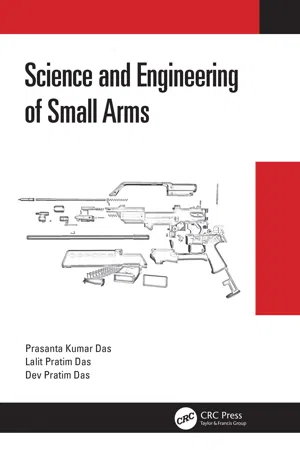
Science and Engineering of Small Arms
Prasanta Kumar Das, Lalit Pratim Das, Dev Pratim Das
- 200 pages
- English
- ePUB (adapté aux mobiles)
- Disponible sur iOS et Android
Science and Engineering of Small Arms
Prasanta Kumar Das, Lalit Pratim Das, Dev Pratim Das
À propos de ce livre
This book initiates with the story of the evolution of firearms to enable the reader to appreciate the sequence of the development of firearms. It discusses different classes of small arms, their mechanics, internal and external ballistics. Further, it covers the design idea of barrels and actions, various operating principles and relevant discussion on ammunition and propellants. The principle of quality in the design of the small arms is also elaborated in the desired degree. The book brings out the relevance of modern manufacturing technologies like MIM and various surface treatments, and polymers for enhancement of product quality. To appreciate the sophistication of the architecture, the book presents the anatomical details of a few small arms of reputes.
Provides complete understanding of overall small weapon systems
Explores mechanics and physics of small arms
Discusses proper design, quality control, and manufacturing process selections for a good weapon
Covers common type of weapon failures and catastrophic failure
Includes relevance of manufacturing processes
The book is aimed at professionals and graduate students in Mechanical Design, Armament Design, Gun Design including personnel in the military, paramilitary, police, and all other armed forces and their maintenance crews.
Foire aux questions
Informations
1 A Story of the Evolution of Firearms
The Story of Firearms

- The aggregation of the component of the gunpowder into a single maneuverable entity
- Identifying a suitable primer to ignite the gunpowder and integrating the same with the main explosive
- Designing a container which will develop the maximum explosive energy when fired
- Working out the design of a projectile of optimum aerodynamic shape and mass to transfer adequate kinetic energy at a desirable range with consistent accuracy
- Developing and understanding the mechanics to ensure the stable trajectory of the projectile
- Overcoming the constraints of making an accurate device that will convert the chemical energy into pressure energy and propel the projectile imparting predetermined directional properties
- Want of a firing mechanism that will consistently activate the firearm when needed
- Evolving a mechanism that will enable to harness rapid and automatic firepower as incorporated in modern-day weapons
- Development of techniques to produce repeatable parts en-masse, to meet the requirement of production of large numbers of weapons with interchangeability
- Lastly, the development of a propellant and explosive that deflagrates or detonates in the manners desired to be used as the main charge and primer
- The propelling forces of the gunpowder could be best extracted by firing through the cylindrical hollow tube because the propellant forces on firing had to develop over space and time.
- The dependence of peak pressure on the inertia of the projectile and the propellant grain size had been only heuristically understood. And the rule of thumb, “The smaller the firearms, the smaller the propellant grain and projectile; and the larger the firearms, the larger the propellant grain and projectiles”, has been applied in the design. This has resulted in a plethora of weapon designs of various sizes and calibers. The issue of caliber and projectile design is a matter of research and investigation even today.
- The fit of the projectile (spherical ball) had to be snug enough to stop the profuse leakage of propelling gas ahead of the projectile, therefore use a precisely machined cylindrical wrought-iron barrel.
- To give optimum ballistics (velocity and range), the projectile must be of spherical geometry. This perception, however, has been proved wrong, as can be seen using non-spherical projectile in modern weapons.
- The issue of managing recoil with the desired projectile energy largely remained in the empirical domain giving birth to several weapon sizes and architecture.

The Emergence of the First Kind of Portable Arms

- Matchlock
- Wheelock
- Flintlock
- Percussion lock
- Matchlock – It was made in the form of an S-shaped arm, called a serpentine. It held a match, and a trigger device used to lower the serpentine, such that the lighted match would fire the priming powder in the pan attached to the side of the barrel. The flash in the pan passed through a small hole in the breech of the gun and ignited the main charge.
- Wheelock – It consisted of a milled edge iron wheel, which was pressed on the fragment of flint to produce a spark on the rotation of the wheel, to ignite the powder. That was very similar to the design of a present-day cigarette lighter.
- Flintlock – In the flintlock mechanism, a spring action caused the frizzen to strike the flint, generating sparks on the gunpowder in the priming pan; the ignited powder, in turn, ignites the main charge in the bore, which pushes the ball forward.
- Percussion lock – Percussion lock used a self-contained, highly sensitive explosive like the modern-day mercury fulminate, or lead styphnate, which when hit sharply detonates and produces a priming flame to ignite the main charge.
Induction of Rifled Barrels
Mass Production of the Firearms
Table des matières
- Cover
- Half-Title
- Title
- Copyright
- Dedication
- Contents
- Foreword
- Preface
- Acknowledgments
- About the Authors
- Summary
- Some Useful Conversion Concept and Formulae
- Chapter 1 A Story of the Evolution of Firearms
- Chapter 2 Introduction to Small Arms
- Chapter 3 Theory of Ammunitions
- Chapter 4 Anatomy of Small Arms
- Chapter 5 Basic Design Concepts
- Chapter 6 Quality of Design
- Chapter 7 Special Processes in Small Arms Manufacturing
- Chapter 8 Surface Treatment of Small Arms
- Chapter 9 Common Defects
- Chapter 10 Catastrophic Failure
- Chapter 11 Proof Parameters
- Chapter 12 Interpreting the Technical Specification
- Multiple Choice Questions for Practice
- Index